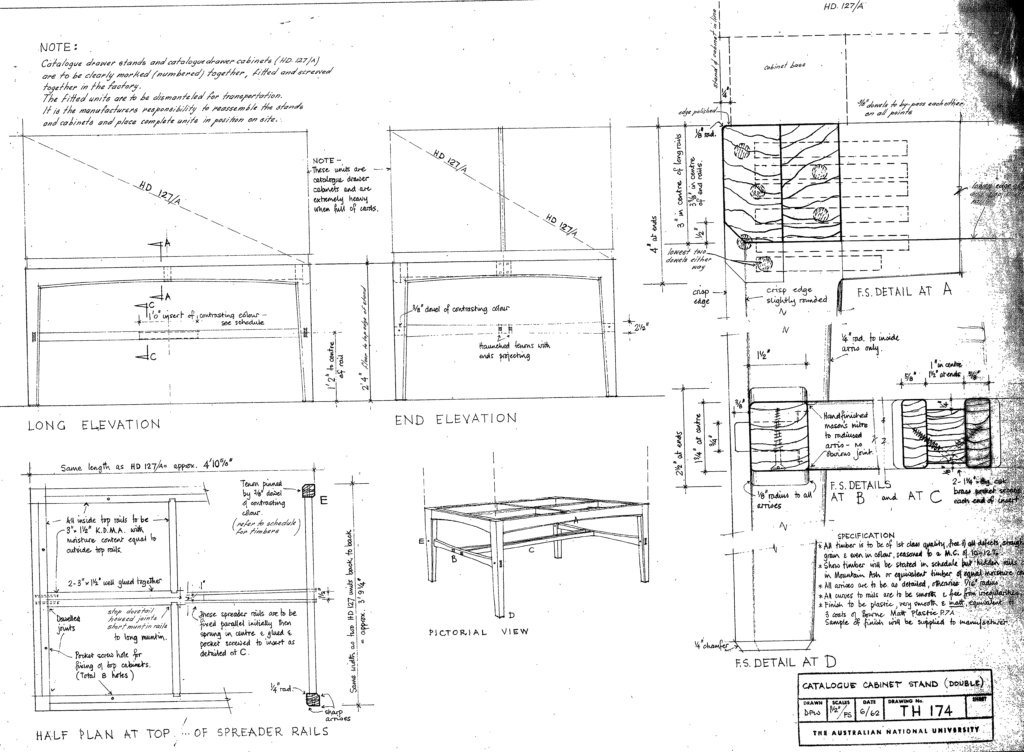Morwenna Vincent (background), who I re-met in 2016 at a U3A course!) and Marjorie Day.
Books were not catalogued on the computer in those days (the University Librarian, Jack Graneek, briefed me in 1962 that cards would always be needed and that computers would never supplant cards !) and so individual cards for each book continued to be housed in specific drawers. Maybe it was an opportunity lost, but we didn’t know much about computers or their impact on cataloguing at that time so I spent a lot of time re-designing the drawer unit mechanisms to ensure that the wear of the drawer runners did not affect function and that the card holding system was the most effective. These were very successful and Fred used the same design in his National Library building a little later (there must now be many hundreds of these drawers in both the Menzies, Chifley and the National libraries). What a scandalous waste!
These were made in Queensland walnut and designed to be in harmony with the Atlas unit and Rare Books units for the same building and later for the Chifley Library – again a sculptural approach based on function.
The descriptive sign holder placed on top and the small paper holders were designed to harmonise with the main unit.
Sadly, these units were all displaced by computerisation of the catalog system – probably around the 1980/90s – where else could they be used? Museum items? Why can’t the bases be re-designed to make some quality meetings tables. Presumably there are similar units in the Chifley Library which are now redundant – they can’t be thrown onto the tip ! ( see later comment).
(PS – when I left the ANU in 1977 there were no computers on anybody’s desk)

I was assured (in 1962) by Jack Graneek, University Librarian, that the future use of computers would not make catalog cards redundant, so on that understanding I put a lot of thought into eliminating the problems seen in existing units, particularly wear from the opening and closing of drawers. The use of clear nylon buttons under the drawers solved that one. A new handle/cardholder was designed (above) together with a foolproof card retention system. It worked well and Fred used it in the National Library a little later.
It was, as always, research on the run, so the element of risk was always on the high side. (relate to David Pye’s comments on ‘risk’ in his book The Nature and Art of Workmanship, (CUP 1968 – after the Menzies opened) Fred bequeathed me this book and also his other book “the Nature of Design’ (Studio Vista 1964) – both excellent books).

I was assured (in 1962) by Jack Graneek, University Librarian, that the future use of computers would not make catalog cards redundant, so on that understanding I put a lot of thought into eliminating the problems seen in existing units, particularly wear from the opening and closing of drawers. The use of clear nylon buttons under the drawers solved that one. A new handle/cardholder was designed (above) together with a foolproof card retention system. It worked well and Fred used it in the National Library a little later.
It was, as always, research on the run, so the element of risk was always on the high side. (relate to David Pye’s comments on ‘risk’ in his book The Nature and Art of Workmanship, (CUP 1968 – after the Menzies opened) Fred bequeathed me this book and also his other book “the Nature of Design’ (Studio Vista 1964) – both excellent books).


